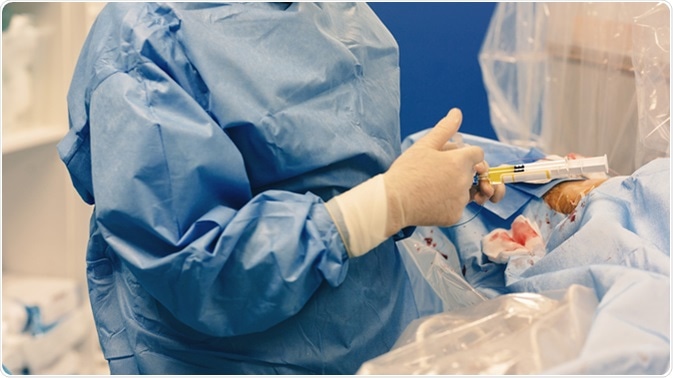Uterine artery embolization (UAE) is a technique used by interventional radiology specialists. It was introduced several decades ago for the treatment of massive uterine hemorrhages due to various causes. This technique aims to treat the bleeding rapidly without resorting to surgical removal of the uterus or other pelvic organs, and may possibly make it easier to stop the hemorrhage without compromising the patient’s fertility.

Indications
The indications for this procedure have been codified, and include:
Gynecological Indications: Strong
- Uterine intramural fibroids (growing within the uterine muscle layer), less than 7 centimeters in size, especially in women who want to avoid surgery or are not fit for surgery due to extreme obesity
- Excessive bleeding during periods
- Pain and pressure-related symptoms in the lower abdomen and pelvis, such as a feeling of bloatness, increased frequency of urination, constipation and having to wake up at night to pass urine
- Dysmenorrhea
Gynecological Indications: Less Strong
- Obstruction of the bladder outlet with hydronephrosis
- Abnormal uterine bleeding
- Pseudoaneurysms of the uterine artery
- Adenomyosis or diffuse enlargement in uterine bulk which occurs because of the proliferation of endometrium into the myometrial layer. It is seen in up to a fifth of women, and may cause abnormal uterine bleeding and pain. Commonly treated by hysterectomy, adenomyosis is also well-controlled by UAE, especially in younger women who want to conceive later, or for anemic patients to help them recover their hemoglobin levels before surgery. UAE for this indication is successful in over 98% of cases.
- Uterine arteriovenous malformations (AVMs) following trauma or uterine curettage, or congenital defects in the development of the uterine capillaries in fetal life. These are diagnosed by arteriograms which have replaced hysteroscopy, Doppler ultrasound and MRI imaging. These were earlier treated by hysterectomy, but now UAE is the therapy of choice in patients with AVMs – especially if they desire to conceive following the procedure.
- To treat extravasation of contrast during angiography for some other cause
- Infertility with fibroids and no other obvious cause, or contraindications to other modes of treatment
- Ectopic pregnancies are deadly, and may occur in both uterine and extrauterine locations. While tubal and ovarian pregnancies are treated by surgical removal, UAE is used to treat interstitial, cervical, abdominal and scar ectopic pregnancies. These are especially useful because they not only obviate surgery in many cases, but also prevent excessive bleeding from the ectopic sac if methotrexate does not act as expected. Moreover, following the removal of an abdominal pregnancy, bleeding from the heavily vascularized implantation site can be reduced by prophylactic UAE.
Childbirth-Related Causes
- Uterine atony causing postpartum hemorrhage
- Uterine bleeding due to childbirth injuries (including vaginal hematomas and cervical lacerations)
- Persistent postpartum hemorrhage after uterine artery ligation or hysterectomy
- Placenta accreta, or deep invasion of the placenta into the myometrium rather than the endometrium, in which case it may help avoid a hysterectomy following childbirth
In all these cases, the success of the procedure is about 80% in cases of experienced physicians, but the patient should be transferred early, thus avoiding unnecessary delay due to last-minute decisions. Its safety is also established and either one or both uterine arteries are embolized.
Contraindications
Patients posted for UAE should be assessed as follows:
- Normal Pap smear report from not more than 12 months ago
- Negative pregnancy test
- No infections or inflammations of the urinary and reproductive tract
- Normal kidney parameters (urea, creatinine)
- Normal blood tests
- Normal thyroid hormone levels
- Normal C-reactive protein levels
Relative Contraindications
In some patients UAE is not recommended if other alternatives are available. These relative contraindications include:
- Having used gonadotropin-releasing hormone within the last three months because of the increased risk of spasm of the uterine arteries (though this is not seen with ulipristat acetate)
- Submucosal or subserosal pedunculated fibroid which may lose its pedicle to infarction and then lie freely within the general abdominal cavity or the uterine cavity, becoming a potential sink for infection
- Fibroids with a primary blood supply from the ovarian artery
- History of pelvic surgery with adhesions
- Fibroids larger than 10 centimeters in size, or multiple fibroids with a uterus larger than the size corresponding to a pregnancy of about 20 weeks, because UAE will not produce adequate size reduction in such cases
Absolute Contraindications
Conditions in which UAE should never be performed include
- Hypersensitivity to contrast agent used in angiography
- Malignancy
- Coagulation disorders which cannot be corrected
- Pregnancy
- Infections or inflammation of the reproductive or urinary tract
- History of pelvic irradiation
- Hyperthyroidism
- Renal failure
- Women who are not ready to accept the approximately 3-20% risk of failure and subsequent absolute need for hysterectomy due to intractable pelvic pain or infection after UAE
Sources
- https://www.ncbi.nlm.nih.gov/pmc/articles/PMC3205683/
- https://www.ncbi.nlm.nih.gov/pubmed/17185687
- https://www.ncbi.nlm.nih.gov/pubmed/18656414
- www.omicsonline.org/…/…lts-of-our-experience-2165-7548-1000342.php
- http://pubmedcentralcanada.ca/pmcc/articles/PMC2001040/
- https://radiopaedia.org/articles/uterine-artery-embolisation
Further Reading
- All Uterine Artery Embolization Content
- Uterine Artery Embolization: Technique and Complications
Last Updated: Feb 27, 2019

Written by
Dr. Liji Thomas
Dr. Liji Thomas is an OB-GYN, who graduated from the Government Medical College, University of Calicut, Kerala, in 2001. Liji practiced as a full-time consultant in obstetrics/gynecology in a private hospital for a few years following her graduation. She has counseled hundreds of patients facing issues from pregnancy-related problems and infertility, and has been in charge of over 2,000 deliveries, striving always to achieve a normal delivery rather than operative.
Source: Read Full Article